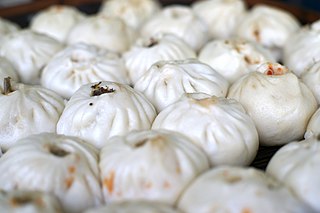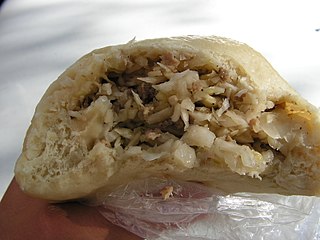 W
WBaozi, or bao, is a type of yeast-leavened filled bun in various Chinese cuisines. There are many variations in fillings and preparations, though the buns are most often steamed. They are a variation of mantou from Northern China.
 W
WBánh bao is a Vietnamese bun based on the Cantonese da bao brought to Vietnam by Cantonese immigrants. It is a ball-shaped bun containing pork or chicken meat, onions, eggs, mushrooms and vegetables, in Vietnamese cuisine. It often has Chinese sausage and a portion of a hard-boiled egg inside. Bánh bao are generally larger than baozi, and are filled with savory fillings, the most common being seasoned ground pork and quail egg. A vegetarian version of bánh bao also exists.
 W
WBaozi, or bao, is a type of yeast-leavened filled bun in various Chinese cuisines. There are many variations in fillings and preparations, though the buns are most often steamed. They are a variation of mantou from Northern China.
 W
WChar siu bao is a Cantonese barbecue-pork-filled bun (baozi). The buns are filled with barbecue-flavored cha siu pork. They are served as a type of dim sum during yum cha and are sometimes sold in Chinese bakeries. Cha siu refers to the pork filling; the word bao means "bun".
 W
WDa Bao (大包) or Dai Bao, is an extra large version of the Chinese steamed bun. When translated, the name literally means big bun. It is commonly sold in Malaysia and Singapore. Compared to the smaller Xiaolongbao, the Da Bao uses fully fermented dough, giving it a less dense texture.
 W
WDampfnudel is a sort of white bread roll or sweet roll eaten as a meal or as a dessert in Germany, Austria and in France (Alsace). It is a typical dish in southern Germany.
 W
WHoppang is a warm snack that is sold throughout South Korea. It is a convenience food version of jjinppang and is typically filled with smooth, sweetened red bean paste.
 W
WHuamo is a Chinese method of decorating specially shaped mantou. Huamo are a feature of the folk art of Shanxi and are often prepared for festivals such as Qingming. Wenxi County in Shanxi is particularly renowned for its huamo. Many shapes such as fish, guanmao, birds and dragons are used.
 W
WJjinppang is a steamed bun, typically filled with red bean paste with bits of broken beans and bean husk. Traditional jjinppang is made of sourdough fermented using the yeast in makgeolli, but younger varieties such as hoppang are often made without fermentation. Warm jjinppang is softer than baked breads due to the higher moisture content, but it hardens as it cools. Thus it is recommended to eat while the bun is still hot. Hardened jjinppang can be steamed again before eaten.
 W
WA longevity peach, or shoutao, is a type of lotus seed bun, sometimes with a filling made of red bean paste or lotus paste. It is white with a red dyed tip with a crease along the side, mimicking the shape of a peach. Occasionally, bakers add green decorations that mimic leaves. The longevity peach is a representation of Peaches of Immortality. According to Chinese folk legends, these peaches ripen every thousands of years, and grant immortality to humans when consumed.
 W
WA lotus seed bun is a Chinese sweet bun found in China. They are prepared by steaming a yeast-leavened dough that contains lotus seed paste. It can be classified as a dim sum, though not exclusively so.
 W
WMandarin rolls, Steamed Mandarin rolls, Flower Buns, or Huā juǎn are a kind of steamed bun originating from China. The rolls are cooked by steaming. It is another one of the staples of Chinese cuisine, which is similar to white bread in western cuisine. Because southern varieties of mandarin rolls are slightly sweet, they can be eaten plain. Sometimes it is eaten with sweetened condensed milk. The rolls are made of wheat flour, water, sugar, soybean oil, vegetable shortening, milk powder, salt, yeast and baking soda.
 W
WMantou, often referred to as Chinese steamed bun, is a white and soft type of steamed bread or bun popular in Northern China. Folk etymology connects the name mantou to a tale about Zhuge Liang.
 W
WPyanse or pigodi is a Russo-Korean steamed pie, bun, or dumpling stuffed with cabbage and meat. It is a popular dish in the Russian Far East, as well as in Koryo-saram communities of Central Asia.
 W
WSiopao, is the Philippine indigenized version of the Cantonese steamed bun called cha siu bao. In Chinese, it is called baozi. It is popular to both Chinese and Filipino restaurants and it is commonly part of dim sum cuisine.
 W
WTingmo is a steamed bread in Tibetan cuisine. It is sometimes described as a steamed bun that is similar to Chinese flower rolls. It does not contain any kind of filling. A tingmo with some type of filling, like beef or chicken, is called a momo.